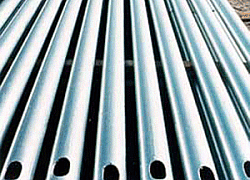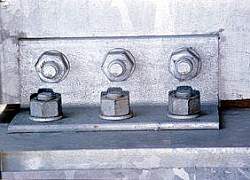
Substructure
Hot-dip galvanized steel's high strength-to-weight ratio helps to save money on transportation, materials, construction handling equipment cost, and time.
Because of the high strength-to-weight ratio of steel, hot-dip galvanized steel bridges are less taxing on the support structure than significantly weightier material options, such as concrete. According to the World Steel Association, the strength-to-weight ratio minimizes substructure costs and can also save money on transportation and handling.
This benefit is particularly important for bridges spanning large bodies of water, wetlands, or environmentally protected areas, which may require cost-effective long-span bridge elements. The ability to use long-span beams minimizes the necessary supports and reduces overall stress to the supporting structure, which will allow for lighter foundations and particularly helpful in areas with poor ground conditions.
Reducing the total weight of the bridgetranslates to cost savings throughout the process. One of the biggest advantages of steel is weight savings and therefore lower erection costs. The lighter weight of the pieces means they will require lighter, less costly handling equipment during construction.
An innovative and lightweight alternative to concrete-encased steel piles for bridges includes the use of galvanized or galvanized and painted H-pile systems. In 2022, Iowa State University published an initial performance study on this system originally developed for the Buffalo Creek Bridge (100-yr bridge design) in 2018.
Hot-dip galvanized steel is the material most commonly used for MSE reinforcements, and occasionally galvanized steel wire mesh is used for facing in both temporary and permanent applications. Hot-dip galvanized steel provides a number of benefits to mechanically stabilized earth systems because of its durability and long life when buried in soil. The backfill soil utilized in MSE is specified to control pH and resistivity, as well as to limit chloride and sulfate content. These limits reduce the soil's corrosivity to the galvanized reinforcements. Therefore, when embedded in specified soil types, galvanized steel provides maintenance-free longevity uniquely suited to the typical 75-100 year design life of MSE structures.
Substructure Components
Abutments |
Anchor Bolts |
Base Plates |
Bolts |
Buried Soil Bridges |
Driven Pilings |
End Dams |
Expansion Dams |
Finger Joint Expansion Dams |
Ground Anchors |
H Piling |
Pile/Pier Caps |
Pier Pilings |
Piers |
Pour-In-Place Forms |
Reinforcing Steel |
Return Walls |
Sheet Piling |
Spiral Shear Connectors |
Wing Walls |






